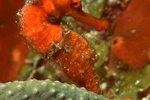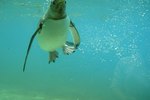
Despite living in the cold Pacific Ocean, the sea otter doesn't have insulating blubber like other ocean mammals such as the whale. Because of this, the sea otter has to eat 25 to 30 percent of its body weight every day to keep its metabolism working right. That's like a 200-pound man eating 50 pounds of hamburger a day. Different types of otter, including sea otters and river otters, eat a wide variety of sea creatures, including urchins. Because of the urchin's hard, spiny shell, otters have to work a little to access the tasty morsels inside.
Hammer Time
If you were trying to open a hard shell, you might start by smacking it. That's exactly what an otter does. Otters get urchin shells open primarily be hitting them, either with a rock or against a rock. When they can, otters will simply smash an urchin shell against a large rock until it cracks or pops open; but they're known to show up to mealtime already equipped with the necessary tools. Otters have little pouches under their arms, in which they can store rocks to use as little hammers for smashing open urchin shells.
Terrible Teeth
They may be cute and cuddly-looking, but otters are equipped to do serious damage with their choppers. An otter's canine teeth are strong and sharp enough to rip open shells, and the rest of their teeth are strong enough to grind and crunch their way through the toughest of materials. Not all otters have the same taste in food, but the ones that have a weakness for urchins are easy to spot -- their teeth actually develop a purple hue from eating so many.
Hunting Habits
Because they have to eat so much, otters spend a lot of their time hunting and foraging for food -- they can dive more 300 feet when they're on the hunt. While they can live in groups ranging from two otters to more than 1,000, they generally prefer to do their hunting alone. They hunt three to four times every day, relying primarily on their vision and touch. An otter's paws and whiskers are particularly important for finding food in dark waters.
Ecosystem Impact
Because they chow down on urchins, sea otters are considered "keystone predators." This means they don't just impact the lives of the urchins they eat, they actually control the ecosystem by doing so. Without the sea otter as a predator, the urchin population would balloon out of control. The urchins would consume too much kelp, reducing the availability of fish in the water. Sea otters play a crucial role in maintaining the stability of the shoreline population and ecosystem.
References
Photo Credits
-
Otter Eating image by Dawn from Fotolia.com
Writer Bio
Tom Ryan is a freelance writer, editor and English tutor. He graduated from the University of Pittsburgh with a degree in English writing, and has also worked as an arts and entertainment reporter with "The Pitt News" and a public relations and advertising copywriter with the Carnegie Library of Pittsburgh.




